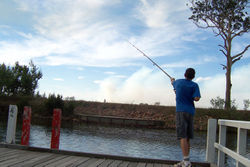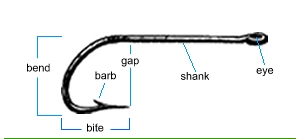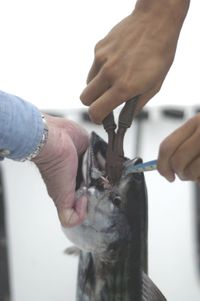Fish Guide
Recreational fishing
|
From Wikipedia the free encyclopedia, by MultiMedia |

Angling is a form of fishing. It is often used synonymously with the terms sport fishing and recreational fishing, although subtle semantic distinctions exist among the three terms. Specifically, angling is the practice of catching fish by means of an "angle" (hook). The hook is usually attached by a line to a fishing rod. A bite indicator such as a float is sometimes, but not always, used. Frequently, the rod is outfitted with a fishing reel that functions as a mechanism for storing, retrieving and paying out the line. The hook can be dressed with lures or bait. Generally, angling is thought of, principally, as a method of sport fishing but some commercial fisheries use methods which are quite similar.
Contents |
Introduction

The use of the hook in angling is descended, historically, from what would today be called a "gorge." The word "gorge", in this context, comes from an archaic word meaning "throat." Gorges were used by ancient peoples to capture fish. A gorge was a long, thin piece of bone or stone attached by its midpoint to a thin line. The gorge would be fixed with a bait so that it would rest parallel to the lay of the line. When a fish would swallow the bait, a tug on the line would cause the gorge to orient itself at right angles to the line, thereby sticking in the fish's gullet.
Angling, insofar as it can be considered equivalent to recreational or sport fishing, is a popular activity in many parts of the world. The species of fish pursued by anglers vary greatly with geography. Among the many species of salt water fish that are caught for sport are swordfish, marlin, tuna, salmon and halibut. In North America, the most popular fresh water sport species include bass, pike, walleye, muskellunge, yellow perch, trout, salmon, catfish, crappie, bluegill and sunfish. In Europe, a large number of anglers fish for species such as carp, pike, tench, rudd, roach, European perch and barbel (especially in stillwaters). Although some fish are sought for their value as food, others are pursued for their fighting abilities or for the difficulty of pursuit.

Which of the various techniques an angler may choose is dictated mainly by the target species and by its habitat. Angling can be separated into two distinct categories: using either artificial or natural baits.
The natural bait angler, with few exceptions, will use a common prey species of the fish as an attractant. The natural bait used may be alive or dead. Common natural baits include worms, leeches, minnows, frogs, salamanders, and insects. Natural baits are effective due to the lifelike texture, odour and colour of the bait presented, and require a relatively simple presentation.
By contrast, the artificial bait angler uses a man-made lure that may or may not represent prey. The lure may require a specialised presentation to impart an enticing action as, for example, in fly fishing.
Laws and regulations managing angling vary greatly, often regionally, within countries. These commonly include permits (licences), closed periods (seasons) where specific species are unavailable for harvest, restrictions on gear types, and quotas. For instance, an angler in the UK is legally required to hold a permit which allows the angler to fish with two rods for non-migratory fish. Any fish captured must be returned to the water otherwise unharmed. In most jurisdictions, there are legal penalties associated with breaching the regulations. In general, anglers are strongly advised to check and become fully aware of all angling laws and regulations in a local area before setting out to fish.
Laws generally prohibit catching fish with hooks other than in the mouth (snagging) or the use of nets other than as an aid in landing a captured fish. Some species, such as bait fish, may be taken with nets, and a few for food. Sometimes, (non-sport) fish are considered of lesser value and it may be permissible to take them by methods like snagging, bow and arrow, or spear. None of these techniques fall under the definition of angling since they do not rely upon the use of a hook and line.
Sometimes considered within the broad category of angling is a fairly recent phenomenon where contestants compete for prizes based on the total weight of fish, usually of a pre-determined species, caught within a specified time (fishing tournaments). Such contests have evolved from local fishing contests into large competitive circuits, where professional anglers are supported by commercial endorsements. Professional anglers are not generally considered to be engaged in commercial fishing, even though they gain an economic reward. Similar competitive fishing exists at the amateur level with local fishing derbies. In general, derbies are distinguished from tournaments; derbies normally require fish to be killed. Tournaments normally deduct points if fish can not be released alive.
Fishing techniques for fresh waters in temperate climes
When fishing, keep at some distance from the fish's expected location, so that your shadow does not fall upon the water and spook your prey. Most anglers also discourage, for similar reasons, laughter, stomping the ground, or loud conversation.
If the water is still, use smaller pieces of bait; if there is a strong current, use large pieces; do this quietly and cautiously because fish can feel vibrations around them and can actually see forms, movement and shadows above the water. It is generally accepted that fish in heavily fished waters become more wary and, consequently, more resistant to capture.
When the wind blows right across the water, fish with your back to the wind, as you will not only be able to throw your line better, but the fish will be on that side, attracted by the flies and other natural bait which the wind will blow into it.
The common earthworm is a universal bait for fresh water angling. Worms can be found in dark damp areas or at night when they surface to conjugate. In attempting to capture earthworms as bait, be aware that they are sensitive to light; the use of a red lens on a flashlight filters the light to wavelengths not detectable by the worm. If a worm senses the light from an unfiltered flashlight, it will quickly seek refuge in its burrow in the earth. Grubs and maggots are considered excellent bait when trout fishing; they can be collected in freshly ploughed earth, under old stumps, under decaying foliage, in rotting animal flesh, etc. Grasshoppers, bees and even ants are also used as bait for trout in their season, although many anglers believe that trout or salmon roe is superior to any other bait.
Many people prefer to fish solely with lures, which are artificial baits designed to entice fish to strike. A common way to fish a soft plastic worm is the Texas Rig.
Responsible use of bait fish

The capture, transportation and culture of bait fish are means by which exotic species of fish and other nuisance organisms are spread between fresh water environments. The irresponsible use and handling of bait fish has caused severe damage to aquatic ecosystems. Using exotic species as bait is generally not recommended.
Conscious effort to maintain a healthy ecosystem is always a factor on reponsible bait use. Like avoiding emptying bait buckets into fishing venues at the end of the day, considering the environment when collecting bait, and avoiding overharvested bait fish areas. That also includes the avoidance of causing severe damage on river banks and stream beds in search for earthworms or other invertebrates.
Awareness that transportation of fish from one location to another can contravene the law and the introduction of fish alien to the vicinity can be a concern since it may introduce diseases and parasites from other areas.
A brief note on saltwater fishing
For saltwater fishing, shrimp is the leading bait. The shedder crab, in its season, is most effective, particularly for striped bass. The soft shell clam, cut in small pieces, is good bait for many kinds of sea fish. Bait fish, whole or cut, and squid and octopus, whole or cut, are also popular saltwater baits.
Preparing roe as a bait
As mentioned above, roe is an excellent bait for trout and salmon. These are also effective baits for many other fresh water fish besides trout. Many anglers preserve it as follows: place the roe, either as separated (ovulated) eggs or as whole skeins (ovaries), in warm water (not hot enough to scald), remove any remnants of the filamentous supporting membranes, rinse well in cold water, and allow to dry. The next day, salt it with 60 g of table salt and 10 g of saltpeter to 500 g of roe. Let it stand another day and then spread it to dry. When it becomes stiff, you can then use it as bait. Many anglers will tie the roe into small nylon bags (4 to 8 eggs per bag, depending on size.) This is ideal for trout, and indeed for almost any fresh water fish.
Catch and release
Catch and release fishing is increasingly practiced, especially by fly anglers. The general principle is that releasing fish allows them to survive, thus avoiding unintended depletion of the population. For species such as marlin and muskellunge but, also, among few bass anglers, there is a cultural taboo against killing fish for food.
The practice of catch and release is abhorred by those who consider it unethical to inflict pain upon a fish for purposes of sport. Some of those who object to releasing fish do not object to killing fish for food.
Adherents of catch and release dispute this charge, pointing out that fish commonly feed on hard and spiky prey items, and as such can be expected to have tough mouths, and also that some fish will re-take a lure they have just been hooked on, a behaviour that is unlikely if hooking were painful.
A definitive science-based conclusion on the issue is unavailable. However, a 2006 study suggested that many fish die because of the stress and injuries inflicted by catch-and-release fishing. Fish were tracked after being caught in a La Crosse, WI fishing tournament. Within a few days, hundreds of the fish were found dead, many from Largemouth Bass virus. According to media reports, Largemouth Bass virus "can cause death when the fish is stressed." [1] On the other hand a number of UK carp waters contain fish that have been caught and released so many times that they have been given names!
Opponents of catch and release fishing would find it preferable to ban or to severely restrict angling. On the other hand, proponents would appeal to the idea that burgeoning human populations place increasing stresses on fish populations and that restricting angling is not reasonable.
In some jurisdictions, in the Canadian province of Manitoba, for example, catch and release is mandatory for some species. Many of the jurisdictions which mandate the live release of sport fish also require the use of artificial lures and barbless hooks to minimise the chance of injury to fish.
Barbless hooks, which can be purchased from major manufacturers or which can be created from a standard hook by removing the barb with pliers, are sometimes resisted by anglers because they believe that increased escapement is the inevitable result. Barbless hooks reduce handling time, thereby increasing survival. Concentrating on keeping the line taut while fighting fish, using recurved point or "triple grip" style hooks on lures, and equipping lures that do not have them with split rings can significantly reduce escapement.
Criticism
Animal protection advocates have tried to raise awareness
about the "suffering" of fish caused by angling. In light of
recent research, some countries, like Germany, have banned
specific types of fishing and the British RSPCA now formally
prosecutes individuals who are cruel to fish.
[2] Experiments done by William Tavolga provide
evidence that fish have pain and fear responses. For
instance, in Tavolga’s experiments, toadfish grunted when
electrically shocked and over time they came to grunt at the
mere sight of an electrode.
[3] Additional tests conducted at both the
University of Edinburgh and the Roslin Institute, in which
bee venom and acetic acid was injected into the lips of
rainbow trout, resulted in fish rubbing their lips along the
sides and floors of their tanks in an effort to relieve
themselves of the pain.[4]
Dr. Lynne Sneddon wrote "Our research demonstrates
nociception and suggests that noxious stimulation in the
rainbow trout has adverse behavioral and physiological
effects. This fulfils the criteria for animal pain."
[5] Dr. Donald Broom at Cambridge University
states, “The scientific literature is quite clear.
Anatomically, physiologically and biologically, the pain
system in fish is virtually the same as in birds and
mammals."[6]
However Professor James Rose of the University of Wyoming
emphasizes the distinction between reaction to injury and
psychological experience of pain. He points out that the
absence of a neocortex in the fish brain means that fish
lack the means to experience pain in the same way as humans.
[7]
See also
External links
- Article on carp fishing with a fly rod.
- Project Gutenberg: The Compleat Angler
- How to fish taken from the Boy's Own Book of Outdoor Sports (early 1900s)
- A starter's guide to angling
Fish Guide, made by MultiMedia | Free content and software
This guide is licensed under the GNU Free Documentation License. It uses material from the Wikipedia.